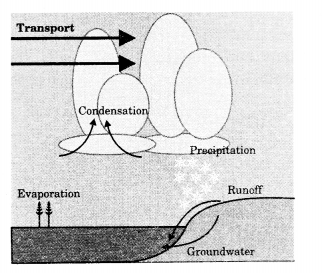Class 11 Geography NCERT Solutions Chapter 15 Life on the Earth
Class 11 Geography Chapter 15 NCERT Textbook Questions Solved.
Multiple choice questions.
Question 1(i).
Which one of the following is included in biosphere?
(a) Only plants
(b) All living and non-living organisms
(c) Only animals
(d) All living organisms
Answer:
(b) All living and non-living
Question 1(ii).
Tropical grasslands are also known as:
(a) The prairies
(b) The savannas
(c) The steppes
(d) None of the above.
Answer:
(b) The savannas
Question 1(iii).
Oxygen combines with iron found in the rocks to form:
(a) Iron carbonate
(b) Iron nitrites
(c) Iron oxides
(d) Iron sulphate.
Answer:
(e) Iron oxides
Question 1(iv).
During photosynthesis, carbon dioxide combines with water in the presence of sunlight to form:
(a) Proteins
(b) Amino acids
(c) Carbohydrates
(d) Vitamins.
Answer:
(c) Carbohydrates.
2. Answer the following questions in about 30 words.
Question 2(i).
What do you understand by the term ‘ecology’?
Answer:
It is a scientific study of the interactions of organisms with their physical environment and with each other.
Question 2(ii).
What is an ecological system? Identify the major types of ecos_ stems in the world.
Answer:
The diversity of life-forms is maintained to bring a kind of balance. This balance is maintained in a particular proportion so that a healthy interaction between the biotic and the abiotic components goes on. The interactions of a particular group of organisms with abiotic factors within a particular habitat resulting in clearly defined energy flows and material cycles on land, water and air, are called ecological systems.
Ecosystems are of two major types: terrestrial and aquatic. Terrestrial ecosystem can be further be classified into ‘biomes’. Aquatic ecosystems can be classed as marine and freshwater ecosystems.
Question 2(iii).
What is food-chain? Give one example of a grazing food-chain identifying the various levels.
Answer:
The sequence of eating and being eaten and the resultant transfer of energy from one level to another is known as the food chain. There are two types of food chain, grazing food chain and detritus food chain.
1. In a grazing food chain, the first level starts with plants as producers and ends with carnivores as consumers at last level, with the herbivores being at the intermediate level. A capture initiated by grazing detritus food chain is based on autographs energy capture initiated by grazing animals and involves the decomposition or breaking down of organic wastes and death matter derived from the grazing food chain. For example plant- beetle- paddy stalk-frog-snake-hawk
2. A detritus food-chain is based on autotrophs energy capture initiated by grazing animals and involves the decomposition or breaking down of organic wastes and dead matter derived from the grazing food-chain.
Question 2(iv).
What do you understand by the term ‘food web’? Give examples.
Answer:
The interconnecting network of species is known as food web. A mouse feeding on grain may be eaten by different secondary consumers (carnivores) and these carnivores may be eaten by other different tertiary consumers (top carnivores). In such situations, each of the carnivores may consume more than one type of prey. As a result, the food- chains get interlocked with one another.
Question 2(v).
What is a biome?
Answer:
A biome is a plant and animal community that covers a large geographical area. The boundaries of different biomes on land are determined mainly by climate. Therefore, a biome can be defined as the total assemblage of plant and animal species interacting within specific conditions. These include rainfall, temperature, humidity and soil conditions. Some of the major biomes of the world are: forest, grassland, desert and tundra biomes.
3. Answer the following questions in about 150 words.
Question 3(i).
What are bio-geochemical cycles? Explain how nitrogen is fixed in the atmosphere.
Answer:
The sun is the source of all energy on earth. This energy initiates life processes in the biosphere through photosynthesis, the main source of food and energy for green plants. A very small fraction of about 0.1 percent of solar energy reaching earth is fixed in photosynthesis. More than half is used for plant respiration and the remaining part is temporarily stored or is shifted to other portions of the plant. During photosynthesis carbon dioxide is converted into organic compounds and oxygen.
The balance of the chemical elements is maintained by a cyclic passage through the tissues of plants and animals. The cycle starts by absorbing the chemical elements by the organism and is returned to the air, water and soil through decomposition. These cyclic movement of chemical elements of the biosphere between the organism and the environment are referred to as bio-geochemical cycles.
Fixing of nitrogen in the atmosphere Action of soil micro-organisms and associated plant roots on atmospheric nitrogen found in pore spaces of the soil comprise the principal source of free nitrogen. Lighting and cosmic radiation can also fix nitrogen in the atmosphere.
Question 3(ii).
What is an ecological balance? Discuss the important measures needed to prevent ecological imbalances.
Answer:
Ecological balance is a state of dynamic equilibrium within a community of organisms in a habitat or ecosystem. It can happen when the diversity of the living organisms remains relatively stable. Gradual changes do take place but that happens only through natural succession. It can also be explained as a stable balance in the numbers of each species in an ecosystem. This occurs through competition and cooperation between different organisms where population remains stable.
This balance is brought about by the fact that certain species compete with one another determined by the environment in which they grow. This balance is also attained by the fact that some species depend on others for their food and sustenance. Such accounts are encountered in vast grasslands where the herbivorous animals (deer, zebras, buffaloes, etc.) are found in plenty.
Ecological balance may be disturbed due to the introduction of new species, natural hazards or human causes. Human interference has affected the balance of plant communities leading to disturbances in the ecosystems. Such disturbances bring about numerous . secondary successions. Human pressure on the earth’s resources has put a heavy toll on the ecosystem. This has destroyed its originality and has caused adverse effects to the general environment. Ecological imbalances have brought many natural calamities like floods, landslides, diseases, erratic climatic occurrences, etc. There is a very close relationship between the plant and animal communities within particular habitats. Diversity of life in a particular area can be employed as an indicator of the habitat factor. Proper knowledge and understanding of such factors provide a strong base for protecting and conserving the ecosystems.
Class 11 Geography Chapter 15 NCERT Extra Questions
Class 11 Geography Chapter 15 Multiple Choice Questions
Question 1.
Which of the following is not a type of biome?
(a) Forest biome
(b) Desert biome
(c) Aquatic biome
(d) Sundri biome.
Answer:
(d) Sundri Biome
Question 2.
Very less rainfall and high rate of evaporation is a feature of which type of biome?
(a) Forest biome
(b) Desert biome
(c) Aquatic biome
(d) Sundri biome.
Answer:
(b) Desert biome
Question 3.
Which of the following is related to ecology?
(a) Birth of living organism
(b) Growth
(c) Development
(d) All of the above.
Answer:
(d) All of the above
Question 4.
All organisms become so much interlinked and interdependent on each other that the life of one cannot be imagined without the other. It is called:
(a) Biome
(b) Ecology
(c) Food chain
(d) Food web.
Answer:
(b) Ecology
Question 5.
Which of the following is included in biotic factors?
(a) Producers
(b) Consumers
(c) Decomposers
(d) All of the above.
Answer:
(d) All of the above
Question 6.
Ecosystems are of two types. These are:
(a) Terrestrial and aquatic ecosystem
(b) Biotic and abiotic ecosystem
(c) Regional and world ecosystem
(d) All of the above.
Answer:
(a) Terrestrial and aquatic ecosystem
Question 7.
Biome is a group of:
(a) Plants and animals
(b) Abiotic elements
(c) Aquatic elements
(d) None of the above.
Answer:
(a) Plants and animals
Question 8.
Which of the following is included in primary consumers?
(a) Carnivores
(b) Herbivores
(c) Decomposers
(d) All of the above.
Answer:
(a) Carnivores
Question 9.
Which of the following is included in secondary consumers?
(a) Carnivores
(b) Herbivores
(c) Decomposers
(d) All of the above.
Answer:
(b) Herbivores
Question 10.
A very small portion of the sunlight received on the earth is used in photosynthesis. What percent is it?
(a) Only 0.50 percent
(b) Only 1 percent
(c) Only 0.1 percent
(d) Only 0.2 percent.
Answer:
(c) Only 0.1 percent.
Class 11 Geography Chapter 15 Very Short Answer Type Questions
Question 1.
Name important biomes of the world.
Answer:
A biome is a plant and animal community that covers at large geographical area. Abiome can be defined as the total assemblage of plant and animal species interacting within specific conditions. These include rainfall, temperature, humidity and soil conditions. Some of the major biomes of the world are forest, grassland, desert and tundra biomes.
Question 2.
Who are primary and secondary consumers?
Answer:
The primary consumers include herbivorous animals like deer, goats,
mice and all plant-eating animals. The carnivores include all the flesh-eating animals like snakes, tigers and lions. Certain carnivores that feed also on carnivores are known as top carnivores like hawks and mongooses.
Question 3.
On whom do primary, secondary and tertiary producers depend?
Answer:
Primary consumers depend on producers who make the food themselves. Secondary consumers depend on primary consumers and tertiary consumers in turn depend on secondary consumers.
Question 4.
Give meaning of food chain with examples.
Answer:
The sequence of eating and being eaten and the resultant transfer of energy from one level to another is known as food chain. There are two types of food chain: grazing food chain and detritus food chain. For example plant- beetle- paddy stalk-frog-snake-hawk.
Question 5.
What kind of changes take place during photosynthesis?
Answer:
During photosynthesis, carbon dioxide is converted into organic compounds and oxygen. Out of the total solar insolation that reaches the earth’s surface, only a very small fraction (0.1 percent) is fixed in photosynthesis. More than half is used for plant respiration and the remaining part is temporarily stored or is shifted to other portions of the plant.
Question 6.
What is water cycle?
Answer:
All living organisms, the atmosphere and the lithosphere maintain between them a circulation of water in solid, liquid or gaseous form referred to as the water or hydrologic cycle.
Question 7.
What is carbon cycle?
Answer:
The carbon cycle is mainly the conversion of carbon dioxide. This conversion is initiated by the fixation of carbon- dioxide from the atmosphere through photosynthesis. Such conversion result in the production of carbohydrates, glucoses that may be converted to other organic compounds such as sucrose, starch, cellulose, etc. Here, some of the carbohydrates are utilised directly by the plant itself. During this process, more carbon dioxide is generated and is released through its leaves or roots during the day. The remaining carbohydrates not being utilised by the plant become part of the plant tissue. Plant tissues are either being eaten by the herbivorous animals or get decomposed by the micro¬organisms. The herbivores convert some of the consumed carbohydrates into carbon dioxide for release into the air through respiration. The microorganisms decompose the remaining carbohydrates after the animal dies.
Question 8.
How many types of biogeochemical cycles are there?
Answer:
There are two types of biogeochemical cycles: the gaseous and the sedimentary cycle. In the gaseous cycle, the main reservoir of nutrients is the atmosphere and the ocean. In the sedimentary cycle, the main reservoir is the soil and the sedimentary and other rocks of the earth’s crust.
Question 9.
How many types of decomposers are there?
Answer:
There are two types of decomposers Scavengers and micro-organisms. Scavengers feed on dead organisms, like vultures and crows. Further breaking down of the dead matter is done by other decomposing agents like bacteria and various micro-organisms.
Question 10.
How does biosphere get formed?
Answer:
The biosphere includes all the living components of the earth. It consists of all plants and animals, including all the micro-organisms that live on the planet earth and their interaction with the surrounding environment. The biosphere and its components are very significant elements of the environment. These elements interact with other components of the natural landscape such as land, water and soil.
Question 11.
What is ecological adaptation?
Answer:
Different types of ecosystems exist with varying ranges of environmental conditions where various plants and animals species have got adapted through evolution. This phenomenon is known as ecological adaption.
Class 11 Geography Chapter 15 Short Answer Type Questions
Question 1.
Write a short note on biosphere.
Answer:
Life on the earth is found almost everywhere. Living organisms are found from the poles to the equator, from the
bottom of the sea to several kilometres in the air, from freezing waters to dry valleys, from under the sea to underground water lying below the earth’s surface. The biosphere includes all the living components of the earth. It consists of all plants and animals, including all the micro-organisms that live on the planet earth and their interactions with the surrounding environment.
The biosphere and its components are very significant elements of the environment. These elements interact with other components of the natural landscape such as land, water and soil. They are also influenced by the atmospheric elements such as the temperature, rainfall, moisture and sunlight. The interactions of biosphere with land, air and water are important to the growth, development and evolution of the organism.
Question 2.
Write and explain about oxygen cycle.
Answer:
Oxygen is the main by-product of photosynthesis. It is involved in the oxidation of carbohydrates with the release of energy, carbon dioxide and water. The cycling of oxygen is a highly complex process. Oxygen occurs in a number of chemical forms and combinations. It combines with nitrogen to form nitrates and with many other minerals and elements to form various oxides such as the iron oxide, aluminium oxide and others. Much of oxygen is produced from the decomposition of water molecules by sunlight during photosynthesis and is released in the atmosphere through transpiration and respiration processes of plants.
Question 3.
Explain the difference between terrestrial eco system and aquatic ecosystem.
Answer:
Difference between terrestrial and aquatic eco system is summarized below:
| Terrestrial Ecosystem | Aquatic Ecosystem |
| Terrestrial ecosystem can be further be classified into ‘biomes’. A biome is a plant and animal community that covers a large geographical area. The boundaries of different biomes on land are determined mainly by climate. Therefore, a biome can be defined as the total assemblage of plant and animal species interacting within specific conditions. Some of the major biomes of the world are: forest, grassland, desert and tundra biomes. | Aquatic ecosystems can be classed as marine and freshwater ecosystems. Marine ecosystem includes the oceans, estuaries and coral reefs. Freshwater ecosystem includes lakes, ponds, streams, marshes and bogs. |
| Rainfall, temperature, soil type, latitude, height, etc determines the boundaries of terrestrial ecosystem. | Water bodies determine the boundaries of aquatic ecosystem. |
Question 4.
How does nitrogen get fixed?
Answer:
Nitrogen is a major constituent of the atmosphere comprising about seventy- nine percent of the atmospheric gases. It is also an essential constituent of different organic compounds such as the amino acids, nucleic acids, proteins, vitamins and pigments. Only a few types of organisms like certain species of soil bacteria and blue green algae are capable of utilising it directly in its gaseous form. Generally, nitrogen is usable only after it is fixed. Ninety percent of fixed nitrogen is biological. The principal source of free nitrogen is the action of soil micro-organisms and associated plant roots on atmospheric nitrogen found in pore spaces of the soil. Nitrogen can also be fixed in the atmosphere by lightning and cosmic radiation.
Class 11 Geography Chapter 15 Long Answer Type Questions
Question 1.
Explain in detail about carbon cycle.
Answer:
The Carbon Cycle: Carbon is one of the basic elements of all living organisms. It forms the basic constituent of all the organic compounds. The biosphere contains over half a million carbon compounds in them. The carbon cycle is mainly the conversion of carbon dioxide. This conversion is initiated by the fixation of carbon dioxide from the atmosphere through photosynthesis. Such conversion results in the production of carbohydrate, glucose that may be converted to other organic compounds such as sucrose, starch, cellulose, etc. Here, some of the carbohydrates are utilised directly by the plant itself. During this process, more carbon dioxide is generated and is released through its leaves or roots during the day.
The remaining carbohydrates not being utilised by the plant become part of the plant tissue. Plant tissues are either being eaten by the herbivorous animals or get decomposed by the micro- organisms. The herbivores convert some of the consumed carbohydrates into carbon dioxide for release into the air through respiration. The micro-organisms decompose the remaining carbohydrates after the animal dies. The carbohydrates that are decomposed by the micro-organisms then get oxidised into carbon dioxide and are returned to the atmosphere.
Question 2.
Explain in detail about food chain.
Answer:
Food Chain: This sequence of eating and being eaten and the resultant transfer of energy from one level to another is known as the food-chain. Transfer of energy that occurs during the process of a food chain from one level to another is known as flow of energy. The food- chains get interlocked with one another. This inter- connecting network of species is known as food web. For example, a plant eating beetle feeding on a paddy stalk is eaten by a frog, which is, in turn, eaten by a snake, which is then consumed by a hawk. This sequence of eating and being eaten and the resultant transfer of energy from one level to another is known as the food-chain.
- Producers: The producers include all the green plants, which manufacture their own food through photosynthesis.
- Primary consumers: The primary consumers include herbivorous animals like deer, goats, mice and all plant-eating animals.
- Carnivores: The carnivores include all the flesh-eating animals like snakes, tigers and lions. Certain carnivores that feed also on carnivores are known as top carnivores like hawks and mongooses.
- Decomposers: Decomposers are those that feed on dead organisms (for example, scavengers like vultures and crows), and further breaking down of the dead matter by other decomposing agents like bacteria and various micro-organisms.
Generally, two types of food-chains are recognised: grazing food-chain and detritus food-chain.
- Grazing food chain: In a grazing food- chain, the first level starts with plants as producers and ends with carnivores as consumers at the last level, with the herbivores being at the intermediate level. There is a loss of energy at each level which may be through respiration, excretion or decomposition. The levels involved in a food- chain range between three to five and energy is lost at each level.
- A detritus food-chain: A detritus food chain is based on autotrophs energy capture initiated by grazing animals and involves the decomposition or breaking down of organic wastes and dead matter derived from the grazing food-chain.
Question 3.
Explain about the working and structure of ecosystem.
Answer:
The structure of an ecosystem involves a description of the available plant and animal species. From a structural point of view, all ecosystems consist of abiotic and biotic factors. Abiotic factors include rainfall, temperature, sunlight, atmospheric humidity, soil conditions, inorganic substances (carbon dioxide, water, nitrogen, calcium, phosphorus, potassium, etc.). Biotic factors include the producers, the consumers (primary, secondary, tertiary) and the decomposers. The producers include all the green plants, which manufacture their own food through photosynthesis.
The primary consumers include herbivorous animals like deer, goat, mice and all plant-eating animals. The carnivores include all the flesh-eating animals like snakes, tigers and lions. Certain carnivores that feed also on carnivores are known as top carnivores like hawks and mongooses. Decomposers are those that feed on dead organisms (for example, scavengers like vultures and crows), and further breaking down of the dead matter by other decomposing agents like bacteria and various micro- organisms.
Question 4.
Explain in detail about nitrogen cycle.
Answer:
Nitrogen is a major constituent of the atmosphere comprising about seventy- nine per cent of the atmospheric gases. It is also an essential constituent of different organic compounds such as the amino acids, nucleic acids, proteins, vitamins and pigments. Only a few types of organisms like certain species of soil bacteria and blue green algae are capable of utilising it directly in its gaseous form. Generally, nitrogen is usable only . after it is fixed. Ninety percent of fixed nitrogen is biological. The principal source of free nitrogen is the action of soil micro-organisms and associated plant roots on atmospheric nitrogen found in pore spaces of the soil.
Nitrogen can also be fixed in the atmosphere by lightning and cosmic radiation. In the oceans, some marine animals can fix it. After atmospheric nitrogen has been fixed into an available form, green plants can assimilate it. Herbivorous animals feeding on plants, in turn, consume some of it. Dead plants and animals, excretion of nitrogenous wastes are converted into nitrites by the action of bacteria present in the soil. Some bacteria can even convert nitrites into nitrates that can be used again by green plants. There are still other types of bacteria capable of converting nitrates into free nitrogen, a process known as denitrification.
Question 5.
Explain the features of different forest biomes of the world.
Answer:
Forest biomes are of following types:
1. Tropical Equatorial Forest: Found in 10° N-S
Temp. 20-25°C, evenly distributed Acidic, poor in nutrients Rich in nutrients
2. Tropical Deciduous Forest: Found in 10°-25° N-S
Temp. 25-30°C, Rainfall, ave. ann. 1,000 mm, seasonal
3. Temperate: Found in Eastern North America, N.E. Asia, Western and Central Europe
Temp. 20-30° C, Rainfall evenly distributed 750- 1,500 mm, Well- defined seasons and distinct winter. Fertile, en-riched with decaying litter
4. Boreal: Found in Broad belt of Eurasia and North America (parts of Siberia, Alaska, Canada and Scandinavia).
Short moist moderately warm summers and long cold dry winter; very low temperatures. Precipitation mostly snowfall 400 -1,000 mm.
Acidic and poor in nutrients, thin soil cover.
Rich in nutrients with little or no organic matter.
Class 11 Geography Chapter 15 HOTS Questions
Question 1.
Differentiate between Grazing Food Chain and detritus food chain.
Answer:
Question 2.
How does an ecosystem work?
Use a diagram to clear the concept of food chain.
Answer:
An ecosystem works with the help of producers and consumers. The producers include all the green plants, which manufacture their own food through photosynthesis. The primary consumers include herbivorous animals like deer, goats, mice and all plant-eating animals. The carnivores include all the flesh eating animals like snakes, tigers and lions. Certain carnivores that feed also on carnivores are known as top carnivores like hawks and mongooses. Decomposers are those that feed on dead organisms (for example, scavengers like vultures and crows), and further breaking down of the dead matter by other decomposing agents like bacteria and various micro¬organisms.
Question 3.
Use a diagram to clear the concept of food chain.
Answer:
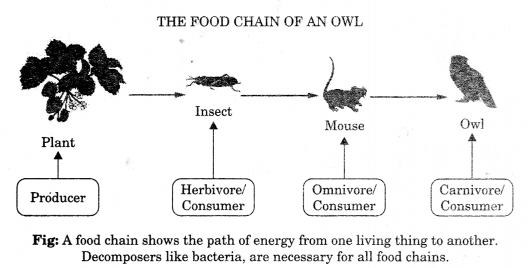
Question 4.
Differentiate between food chain and food web.
Answer:
Food chains follow a single path as animals eat each other.
Example:
- The sun provides food for grass.
- The grass is eaten by a grasshopper.
- The grasshopper is eaten by a frog.
- The frog is eaten by a snake.
- The snake is eaten by a hawk.
Food webs show how plants and animals are interconnected by different paths.
Example:
- Trees produce acorns which act as food for many mice and insects.
- Because there are many mice, weasels and snakes have food.
- The insects and the acorns also attract birds, skunks, and opossums.
- With the skunks, opposums, weasels and mice around, hawks, foxes, and owls can find food.
- They are all connected. Like a spiders web, if one part is removed, it can affect the vchole web.
Map Skills
Question 1.
Show diagram for carbon cycle
Answer:
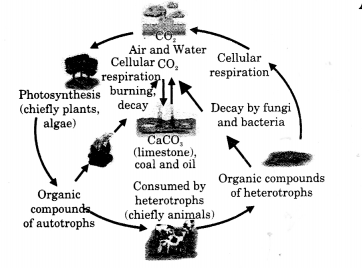
Question 2.
Show a diagram explaining nitrogen cycle.
Answer:
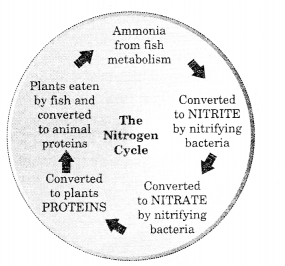
Question 3.
Show oxygen cycle and its reservoirs with the help of a diagram.
Answer:
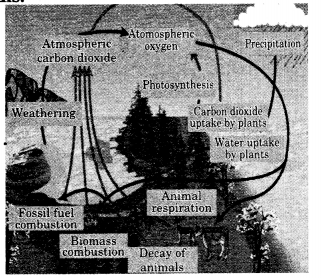
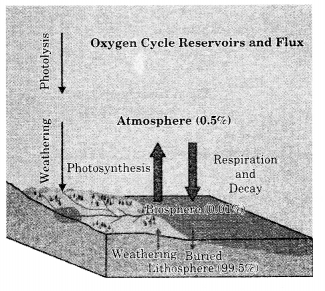
Question 4.
Show with the help of a diagram, the water or hydrological cycle.
Answer:
